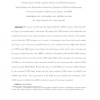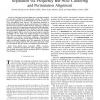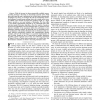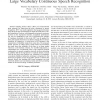130
click to vote
TASLP
2011
14 years 7 months ago
2011
—We present a simple and efficient feature modeling approach for tracking the pitch of two simultaneously active speakers. We model the spectrogram features of single speakers u...
113
Voted
TASLP
2011
14 years 7 months ago
2011
111
Voted
TASLP
2011
14 years 7 months ago
2011
—This paper presents a blind source separation method for convolutive mixtures of speech/audio sources. The method can even be applied to an underdetermined case where there are ...
102
Voted
TASLP
2011
14 years 7 months ago
2011
Abstract—A probabilistic kernel approach to pairwise preference learning based on Gaussian processes is applied to predict preference judgments for sound quality degradation mech...
119
click to vote
TASLP
2011
14 years 7 months ago
2011
—With the increase in cheap commercially available sensors, recording meetings is becoming an increasingly practical option. With this trend comes the need to summarize the recor...
114
click to vote
TASLP
2011
14 years 7 months ago
2011
Abstract—This paper proposes methods for information processing of audio streams using methods of information geometry. We lay the theoretical groundwork for a framework allowing...
173
click to vote
TASLP
2011
14 years 7 months ago
2011
The time delay of arrival (TDOA) between multiple microphones has been used since 2006 as a source of information (localization) to complement the spectral features for speaker di...
119
Voted
TASLP
2011
14 years 7 months ago
2011
— Missing feature theory (MFT) has demonstrated great potential for improving the noise robustness in speech recognition. MFT was mostly applied in the log-spectral domain since ...
115
Voted
TASLP
2011
14 years 7 months ago
2011
—Time-domain algorithms for blind separation of audio sources can be classified as being based either on a partial or complete decomposition of an observation space. The decompo...
111
Voted
TASLP
2011
14 years 7 months ago
2011
—Existing speech enhancement algorithms can improve speech quality but not speech intelligibility, and the reasons for that are unclear. In the present paper, we present a theore...




